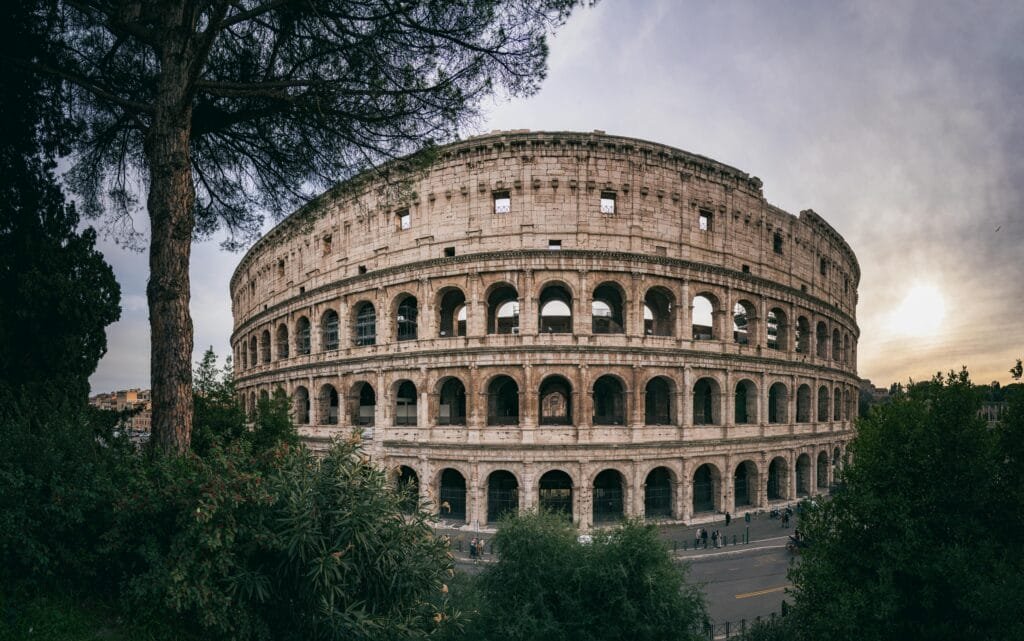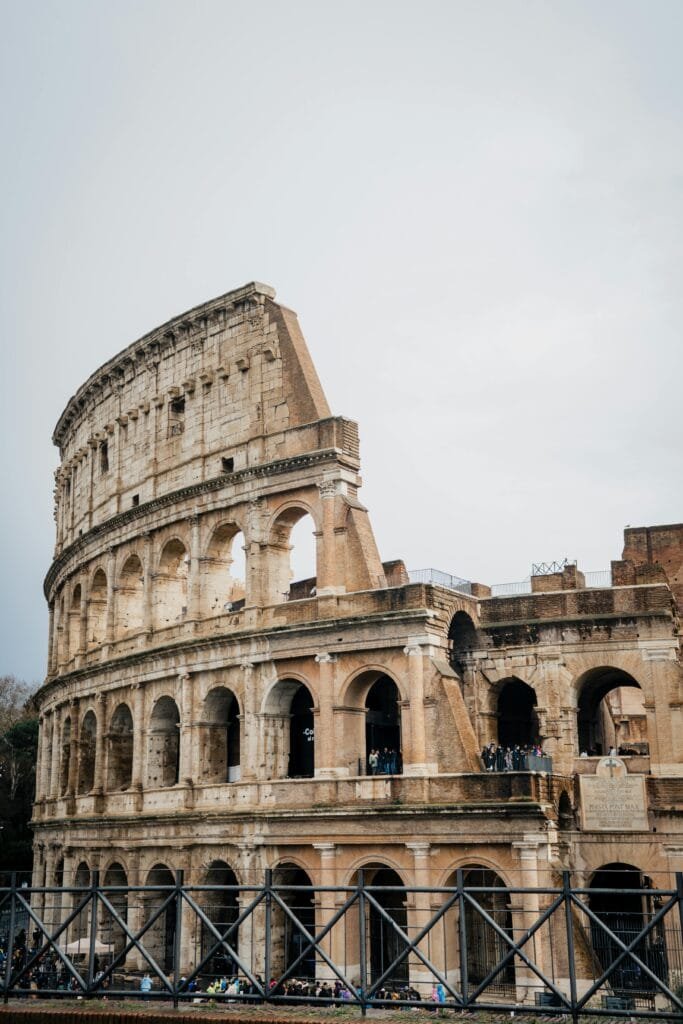Table of Contents
Introduction to the Colosseum

The Colosseum, also known as the Flavian Amphitheater, is one of the most iconic landmarks in the world. Standing proudly in the heart of Rome, Italy, this colossal structure serves as a powerful symbol of the Roman Empire’s grandeur and engineering marvel. Constructed nearly 2,000 years ago under the emperors Vespasian, Titus, and Domitian, it was designed to hold up to 80,000 spectators, making it the largest amphitheater in the ancient world. The Colosseum hosted not only gladiatorial battles but also mock naval battles, animal hunts, and public executions, offering an insight into the entertainment culture of ancient Rome.
Despite suffering significant damage from earthquakes and stone robbers over the centuries, the Colosseum remains a symbol of ancient Roman architecture and a must-see for history enthusiasts. Today, it continues to attract millions of visitors annually, who come to marvel at its impressive ruins, explore its underground chambers, and uncover the rich stories of triumph, tragedy, and survival that echo through its ancient walls.
The Origins of the Colosseum
Emperor Vespasian commissioned the Colosseum in AD 70–72 as a gift to the Roman people. His son, Emperor Titus, completed it in AD 80, and Emperor Domitian later modified it. Together, these rulers formed the Flavian Dynasty, which is why people also call the amphitheater the Flavian Amphitheater.
The primary purpose of the Colosseum was to entertain the masses with gladiatorial games, wild animal hunts, and dramatic reenactments of famous battles. It served as a propaganda tool, showcasing the wealth, engineering skills, and military dominance of Rome. The games were free for the public, reinforcing the bond between the rulers and the citizens.
Architectural Marvel of the Colosseum

The Colosseum is an engineering masterpiece that has stood the test of time. Builders used concrete, travertine limestone, tuff (a type of volcanic rock), and brick-faced concrete to construct the Colosseum. They designed the structure with four levels of seating, allowing it to accommodate up to 50,000–80,000 spectators.
Key architectural features include:
- Arched Entrances: 80 arched entrances ensured smooth crowd movement.
- Hypogeum (Underground Chambers): A network of tunnels and cages below the arena floor housed gladiators and wild animals before fights.
- Velarium (Retractable Awning): A giant canvas roof system provided shade for spectators.
The design of the Colosseum later inspired modern stadiums, proving how advanced Roman architecture was.
The Spectacle of Gladiatorial Combat
Gladiatorial contests were the highlight of Colosseum events. These warriors, often slaves or prisoners of war, were trained to fight to the death for public entertainment. Some, however, earned fame and freedom through their victories.
Aside from gladiatorial combat, the Colosseum hosted:
- Animal Hunts: non-native beasts like lions, elephants, and bears were brought from Africa and Asia to battle hunters.
- Mock Naval Battles: The arena was occasionally flooded to reenact sea battles.
- Public Executions: Criminals and prisoners were thrown into the arena to face certain death.
These events reinforced Roman values of bravery, discipline, and strength while providing grand entertainment for the masses.
The Decline and Damage Over the Centuries
The Colosseum remained in use for over 400 years, but after the fall of the Roman Empire, it gradually fell into ruin. Several factors contributed to its decline:
- Earthquakes: Several quakes in the 5th century and later caused severe structural damage.
- Looting: Stones, metal clamps, and statues were removed to build churches and palaces in Rome.
- Neglect: By the Middle Ages, the once-great amphitheater became a quarry, monastery, and even a fortress.
Despite the destruction, efforts to preserve the Colosseum began in the 18th century, recognizing its historical significance.
The Colosseum in Modern Times
Today, the Colosseum stands as one of the most visited monuments in the world, attracting millions of tourists each year. It is recognized as a UNESCO World Heritage Site and is part of the New Seven Wonders of the World. Despite centuries of damage, restoration efforts have helped preserve its grandeur, allowing visitors to explore its ancient corridors and learn about its glorious past.
Modern-day significance includes:
- Tourism: The Colosseum generates significant revenue for Italy’s tourism industry.
- Cultural and Political Events: Occasionally used for special events, including religious ceremonies led by the Pope.
- Restoration Projects: Ongoing efforts aim to stabilize and restore parts of the structure to ensure its preservation for future generations.
Walking through the Colosseum today, visitors can almost hear the echoes of roaring crowds and clashing swords from its vibrant past.
Secrets and Lesser-Known Facts About the Colosseum
The Colosseum is full of hidden details and intriguing stories. Here are some lesser-known facts:
- Underground Tunnels and Chambers: The hypogeum, an elaborate underground network, housed gladiators and animals before they entered the arena. Recent restorations have opened parts of this area to the public.
- Symbolism in Architecture: The structure was designed with elements symbolizing Rome’s power, including statues and intricate carvings of gods and emperors.
- Christian Associations: Many believe the Colosseum was a site where early Christians were martyred, though historical evidence remains debated.
The Colosseum’s Influence on Architecture and Culture
The Colosseum has inspired countless architectural designs, from modern sports stadiums to amphitheaters around the world. Its oval shape and tiered seating are now standard features in stadium construction.
Cultural impact includes:
- Movies and TV Shows: Featured in films like Gladiator (2000), making it a symbol of ancient Roman history.
- Literature and Art: Frequently depicted in paintings, books, and poetry throughout history.
- Symbol of Italian Heritage: Used in national branding and historical preservation efforts.
The Colosseum remains a testament to Roman ingenuity, influencing global architecture and culture even today.
Map Location
Best Time and Tips for Visiting the Colosseum

If you’re planning a trip to the Colosseum, here are some key tips:
Best Time to Visit
Early morning or late afternoon to avoid crowds. Spring and fall offer pleasant weather.
Ticket Information
Booking Colosseum tickets online is a convenient way to secure your visit to one of Rome’s most iconic landmarks. By purchasing Colosseum tickets in advance, you can avoid long queues and ensure entry during your preferred time. Various ticket options are available, including general admission, guided tours, and special access to areas like the underground and arena floor. You can easily book Colosseum tickets through the official website or authorized partners, offering flexibility and added services such as audio guides and skip-the-line passes.
To make the most of your visit, consider booking Colosseum tickets with combined access to nearby attractions like the Roman Forum and Palatine Hill. These combined tickets offer great value and help you explore the rich history of ancient Rome. For the best experience, be sure to check for discounts and family packages available on the official ticketing websites.
Nearby Attractions
The Roman Forum and Palatine Hill are must-see sites located next to the Colosseum.
By planning wisely, visitors can fully appreciate this incredible historical wonder.
Conclusion
The Colosseum is more than just an ancient ruin—it is a symbol of Rome’s legacy, resilience, and architectural brilliance. From thrilling gladiatorial battles to its present status as a world-famous monument, it continues to captivate and inspire people worldwide. Whether you’re a history enthusiast or a curious traveler, visiting the Colosseum is a journey back in time, offering a glimpse into the grandeur of the Roman Empire.
Read More…
For a detailed exploration of Vatican City and its importance in Catholicism, you can read more about it on World Travel Eye’s in-depth guide on Vatican City. This article covers the key landmarks, history, and cultural significance of Vatican City, offering insight into its religious importance and the treasures it holds, including the Vatican Museums and St. Peter’s Basilica.
FAQs
- Why is the Colosseum called the Flavian Amphitheater?
The Colosseum is called the Flavian Amphitheater because Emperors Vespasian, Titus, and Domitian built it during the Flavian Dynasty. - How many people could the Colosseum hold?
Estimates suggest it could accommodate between 50,000 and 80,000 spectators. - What happened to the Colosseum after the fall of Rome?
It suffered damage from earthquakes, looting, and repurposing of materials, but later restoration efforts preserved it. - Can you go inside the underground chambers of the Colosseum?
Yes, guided tours allow visitors to explore the hypogeum, where gladiators and animals were kept before battles. - How long did it take to build?
Construction began in AD 70 and was completed in AD 80, taking about 10 years. - Can I buy Colosseum tickets on the day of my visit?
Yes, you can buy Colosseum tickets on the day of your visit, but it’s recommended to book them online in advance to skip the long lines and guarantee your preferred time. Visit colosseum tickets for more details.
For more detailed information, please visit the official website of the colosseo-roma.it

